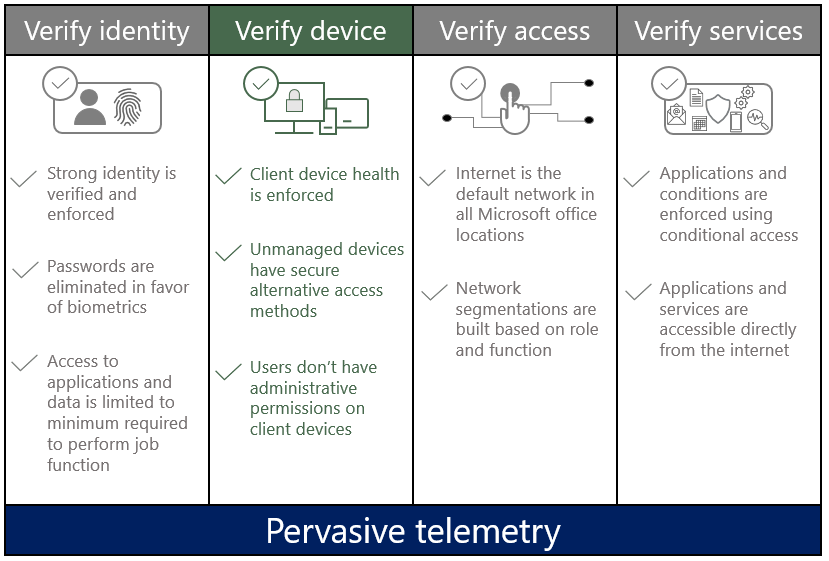 Here at Microsoft, we’re using our Zero Trust security model to help us transform the way we verify device health across all devices that access company resources. Zero Trust supplies an integrated security philosophy and end-to-end strategy that informs how our company protects its customers, data, employees, and business in an increasingly complex and dynamic digital world.
Here at Microsoft, we’re using our Zero Trust security model to help us transform the way we verify device health across all devices that access company resources. Zero Trust supplies an integrated security philosophy and end-to-end strategy that informs how our company protects its customers, data, employees, and business in an increasingly complex and dynamic digital world.
Verified device health is a core pillar of our Microsoft Digital Zero Trust security model. Because unmanaged devices are an easy entry point for bad actors, ensuring that only healthy devices can access corporate applications and data is vital for enterprise security. As a fundamental part of our Zero Trust implementation, we require all user devices accessing corporate resources to be enrolled in device-management systems.
Verified devices support our broader framework for Zero Trust, alongside the other pillars of verified identity, verified access, and verified services.

[Explore verifying identity in a Zero Trust model. | Unpack implementing a Zero Trust security model at Microsoft. | Discover enabling remote work: Our remote infrastructure design and Zero Trust. | Watch our Enabling remote work infrastructure design using Zero Trust video.]
Verifying the device landscape at Microsoft
The device landscape at Microsoft is characterized by a wide variety of devices. We have more than 220,000 employees and additional vendors and partners, most of whom use multiple devices to connect to our corporate network. We have more than 650,000 unique devices enrolled in our device-management platforms, including devices running Windows, iOS, Android, and macOS. Our employees need to work from anywhere, including customer sites, cafes, and home offices. The transient nature of employee mobility poses challenges to data safety. To combat this, we are implementing device-management functionality to enable the mobile-employee experience—confirming identity and access while ensuring that the devices that access our corporate resources are in a verified healthy state according to the policies that govern safe access to Microsoft data.
Enforcing client device health
Device management is mandatory for any device accessing our corporate data. The Microsoft Endpoint Manager platform enables us to enroll devices, bring them to a managed state, monitor the devices’ health, and enforce compliance against a set of health policies before granting access to any corporate resources. Our device health policies verify all significant aspects of device state, including encryption, antimalware, minimum OS version, hardware configuration, and more. Microsoft Endpoint Manager also supports internet-based device enrollment, which is a requirement for the internet-first network focus in the Zero Trust model.
We’re using Microsoft Endpoint Manager to enforce health compliance across the various health signals and across multiple client device operating systems. Validating client device health is not a onetime process. Our policy-verification processes confirm device health each time a device tries to access corporate resources, much in the same way that we confirm the other pillars, including identity, access, and services. We’re using modern endpoint protection configuration on every managed device, including preboot and postboot protection and cross-platform coverage. Our modern management environment includes several critical components:
- Microsoft Azure Active Directory (Azure AD) for core identity and access functionality in Microsoft Intune and the other cloud-based components of our modern management model, including Microsoft Office 365, Microsoft Dynamics 365, and many other Microsoft cloud offerings.
- Microsoft Intune for policy-based configuration management, application control, and conditional-access management.
- Clearly defined mobile device management (MDM) policy. Policy-based configuration is the primary method for ensuring that devices have the appropriate settings to help keep the enterprise secure and enable productivity-enhancement features.
- Windows Update for Business is configured as the default for operating system and application updates for our modern-managed devices.
- Microsoft Defender for Endpoint (MDE) is configured to protect our devices, send compliance data to Azure AD Conditional Access, and supply event data to our security teams.
- Dynamic device and user targeting for MDM enables us to supply a more flexible and resilient environment for the application of MDM policies. It enables us to flexibly apply policies to devices as they move into different policy scopes.
Providing secure access methods for unmanaged devices
While our primary goal is to have users connect to company resources by using managed devices, we also realize that not every user’s circumstances allow for using a completely managed device. We’re using cloud-based desktop virtualization to provide virtual machine–based access to corporate data through a remote connection experience that enables our employees to connect to the data that they need from anywhere, using any device. Desktop virtualization enables us to supply a preconfigured, compliant operating system and application environment in a pre-deployed virtual machine that can be provisioned on demand.
Additionally, we’ve created a browser-based experience allowing access, with limited functionality, to some Microsoft 365 applications. For example, an employee can open Microsoft Outlook in their browser and read and reply to emails, but they will not be able to open any documents or browse any Microsoft websites without first enrolling their devices into management.

How we treat the devices that our employees and partners use to access corporate data is an integral component of our Zero Trust model. By verifying device health, we extend the enforcement capabilities of Zero Trust. A verified device, associated with a verified identity, has become the core checkpoint across our Zero Trust model. We’re currently working toward achieving better control over administrative permissions on client devices and a more seamless device enrollment and management process for every device, including Linux–based operating systems. As we continue to strengthen our processes for verifying device health, we’re strengthening our entire Zero Trust model.





